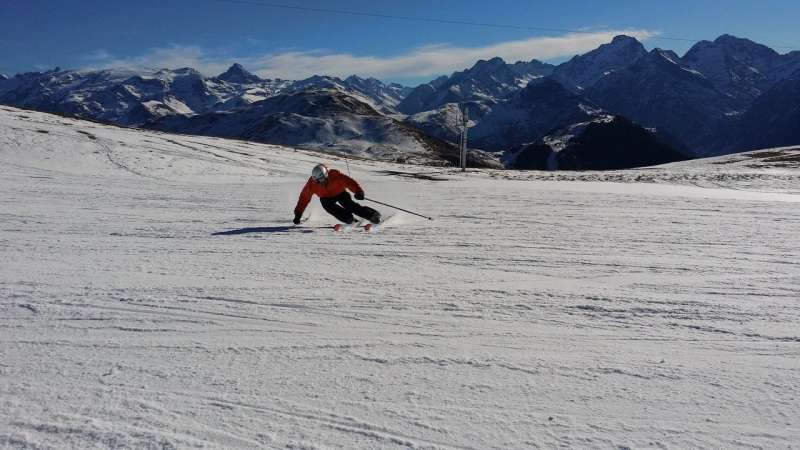Brain-machine interface study suggests how brains prepare for action

Somewhere right now in Pyeongchang, South Korea, an Olympic skier is thinking through the twists and spins she'll make in the aerial competition, a speed skater is visualizing how he'll sneak past a competitor on the inside line, and a curler is imagining the perfect sweep.
It's called mental rehearsal, and psychologists and athletes alike know that it works: picturing ourselves going through routines, whether it's figure skating or something more mundane, improves our chances of success. Now, neuroscientists report Feb. 15 in Neuron, they've learned how the brain learns physical tasks, even in the absence of real-world movement, and found that it could hinge on getting the mind to the right starting place, ready to perfectly execute everything that follows.
"Mental rehearsal is tantalizing, but difficult to study," said Saurabh Vyas, a graduate student in bioengineering and the paper's lead author. That's because there's no easy way to peer into a person's brain as he imagines himself racing to a win or practicing a performance. "This is where we thought brain-machine interfaces could be that lens, because they give you the ability to see what the brain is doing even when they're not actually moving," he said.
Although there are some important caveats, the results could point the way toward a deeper understanding of what mental rehearsal is and, the researchers believe, to a future where brain-machine interfaces, usually thought of as prosthetics for people with paralysis, are also tools for understanding the brain, said Krishna Shenoy, the Hong Seh and Vivian W. M. Lim Professor in the School of Engineering, a member of Stanford Bio-X and the Stanford Neurosciences Institute and the study's senior author.
What are you thinking?
The idea for the study came while thinking about how people learn to use brain-machine interfaces to perform a task, Vyas said. In a typical setup, a person – or, very often, a monkey – has to learn to move a cursor around a computer screen using only patterns of activity in the brain, not hand or other movements. That got Vyas wondering whether what people (or monkeys) learned using brain-machine interfaces might somehow transfer, in a way similar to mental rehearsal, to physical movements.
"He's just sitting there thinking, and as he's thinking he's getting better and better" at moving the cursor, Vyas said, referring to one of the monkeys he studied. "The natural question becomes: What happens if you switch to another context, where now he actually has to generate muscle activity? Do you see the effects of that learning in that new context?"
The short answer is yes, mental learning does transfer to physical performance. Vyas initially taught two monkeys outfitted with brain-machine interfaces to move a cursor from one place to another on a computer screen using only their minds, then introduced a complication, called a visuomotor rotation: what mental signals they previously used to move a cursor up would now move it at an angle, say 45 degrees clockwise. The monkeys easily adapted, and that adaptation carried over when they repeated the same task using their hands, rather than the brain-machine interface, to control the cursor directly. Now, if the monkeys wanted to move the cursor up, they moved their hands 45 degrees clockwise.
This suggested that the monkeys were doing something like mental rehearsal, Vyas said – what they had learned to do in their minds, they could then do with their hands. Some additional experiments and an analysis of recorded neural activity suggest the reason why: rehearsing the task with a brain-machine interface got patterns of activity in the monkeys' brains into just the right spot, so they could carry out the same rotation task with their hands, even though they had never done so before.
A new way to probe the mind
"There are key differences between our paradigm and true mental rehearsal," Vyas said, and there are reasons to be cautious about interpreting the results too broadly. For one thing, one can't just ask a monkey to imagine skiing down a mountain slope, as one could with a person. For another, mentally rehearsing a task is not the same as using a brain-machine interface to do it. In the latter case, people get feedback on how they're doing, something they can only imagine in mental rehearsal.
"We can't prove the connection beyond a shadow of a doubt," Shenoy said, but "this is a major step in understanding what mental rehearsal may well be in all of us." The next steps, he and Vyas said, are to figure out how mental rehearsal relates to practice with a brain-machine interface – and how mental preparation, the key ingredient in transferring that practice to physical movements, relates to movement.
Meanwhile, Shenoy said, the results demonstrate the potential of an entirely new tool for studying the mind. "It's like building a new tool and using it for something," Shenoy said. "We used a brain-machine interface to probe and advance basic science, and that's just super-exciting."


















